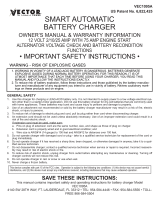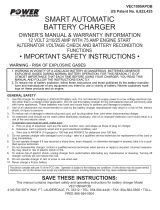
• 13 •
The • CHARGED (green) LED will light if the output of the charging system
is at the normally desired level.
The CHARGING LED does not light in the alternator test mode.•
The • CONNECTED LED lights if the tester detects a connection.
When the tester digital display is set to • VOLTAGE, the CHARGED and
CHARGING LEDs won’t light (it could be testing a battery or an alterna-
tor).
ALTERNATOR TESTING NOTES16.3
The alternator percent display can range from 0 to 199.•
The DIGITAL • DISPLAY cannot be set to ALTERNATOR % during charg-
ing.
An • ALTERNATOR % of 0 does not indicate an ALTERNATOR output of
0V, it indicates an output too low to charge the battery.
An • ALTERNATOR % of 199 does not indicate an Alternator Voltage
nearly twice the voltage of a normal alternator.
BATTERY PERCENT AND CHARGE TIME17.
This charger adjusts the charging time in order to charge the battery com-
pletely, efciently and safely. The microprocessor automatically makes the
necessary decisions. However, this section includes guidelines that can be
used to estimate charging times.
The duration of the charging process depends on three factors:
Battery State17.1 – If a battery has only been slightly discharged, it can be
charged in less than a few hours. The same battery could take up to 10
hours if very weak. The battery state can be estimated by using the built-in
tester. The lower the reading, the longer charging will take.
Battery Rating17.2 – A higher rated battery will take longer to charge than
a lower rated battery under the same conditions. A battery is rated in
ampere-hours (AH), reserve capacity (RC) and cold cranking amps (CCA).
The lower the rating, the quicker the battery will be charged.
Charge Rate – 17.3 The charge rate is measured in amps. This charger pro-
vides charge rates of 2A, 12A, and 30A. The 100A rate is for engine start
only. The 2A rate is for charging smaller batteries such as those used for
motorcycles and garden tractors. Such batteries should not be charged
using the MEDIUM TO LARGE BATTERY setting, which is for charging
larger batteries. In the MEDIUM TO LARGE BATTERY mode, the charger
begins at the 12A rate and increases the charge rate if it determines that
the battery can accept the 30A rate. All charging modes will decrease the
charge rate as the battery approaches maximum charge.
After the charging process has started, the digital display can be used to
determine charging progress by selecting the BATTERY % mode.



















